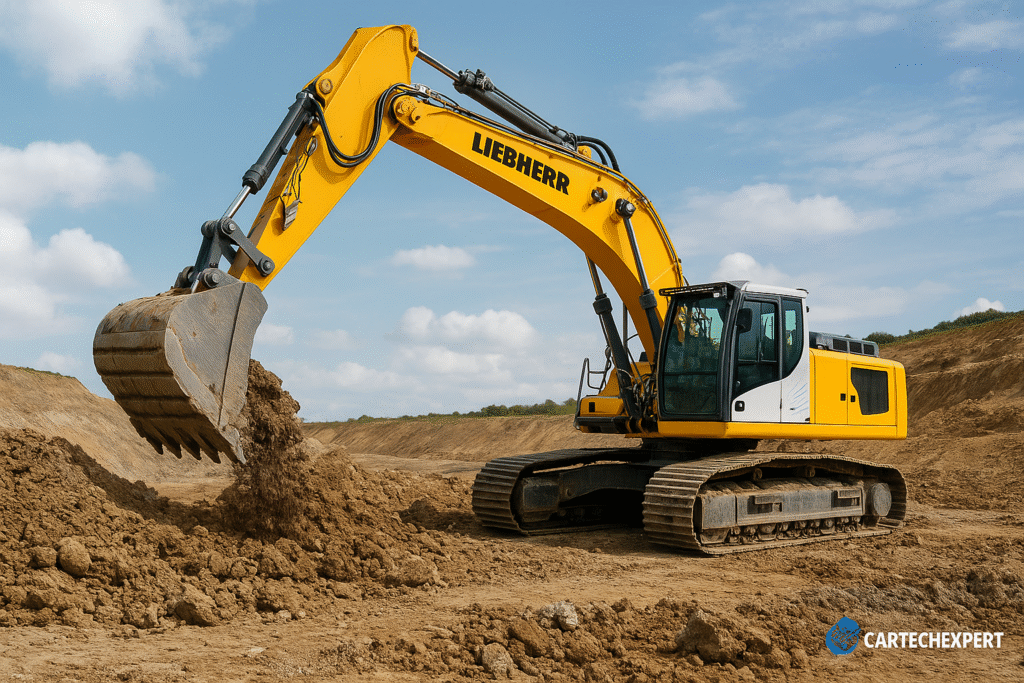Physical Address
Arthur Avenue , BrookField , ILLINOIS , 60513 , United State

Explore how Liebherr evolved from a family workshop into a global symbol of reliability and innovation in the heavy equipment world.
When you think of reliability, durability, and meticulous engineering, one name consistently stands out in the heavy equipment world — Liebherr. For decades, Liebherr has represented not only mechanical excellence but also the philosophy of building for the long term. From towering cranes on skyscrapers to powerful excavators digging deep into the earth, Liebherr’s influence spans industries and continents.
If you’ve read our earlier articles on Caterpillar and Komatsu, you already understand how major brands shaped the evolution of heavy machinery. Yet, Liebherr’s story stands apart — it’s about a family vision that grew into a multinational empire rooted in craftsmanship and continuous innovation.
Liebherr’s journey began in 1949, when Hans Liebherr, a German engineer, identified a massive opportunity in post-war reconstruction. The demand for affordable and mobile tower cranes was high, but the available machines were expensive and complex. Hans set out to solve this with an innovative design — the TK 10 tower crane — which could be transported and assembled easily on construction sites.
This invention was more than a business success; it was the foundation of a philosophy centered around solving real-world engineering problems with practicality and precision. From this single breakthrough, the Liebherr Group was born.
The TK 10’s success catapulted Liebherr into prominence across Europe. The company quickly expanded its crane line and became synonymous with reliability. Unlike many manufacturers that relied on heavy, immovable designs, Liebherr emphasized modularity, efficiency, and operator safety — principles that still define its cranes today.
By the 1950s, Liebherr was not only producing cranes but also entering the fields of concrete mixing and material handling — setting the stage for future diversification into heavy earthmoving machinery.
As Europe rebuilt, Liebherr expanded beyond its borders. New facilities were established in Ireland, France, and Austria, followed by manufacturing bases in Africa and the Americas. By the 1960s, the company’s product line included excavators, mining trucks, wheel loaders, and diesel engines.
Each product was designed with precision components, crafted in-house to maintain quality control — a strategy that kept Liebherr independent and self-sufficient, even as competitors outsourced production.
Liebherr’s excavators became a benchmark in hydraulic performance and operator comfort. The company introduced fully hydraulic excavators in the 1950s, setting new standards for control and responsiveness.
Over the decades, Liebherr excavators evolved into highly specialized machines — from compact models for urban worksites to colossal mining excavators such as the R 9800, one of the world’s largest hydraulic shovels.
While Liebherr became known for its excavators, its cranes remained a cornerstone of its reputation. From mobile cranes to crawler cranes and offshore lifting systems, Liebherr set new records in load capacity and stability.
Their LTM 11200-9.1 remains one of the most powerful all-terrain cranes in the world, capable of lifting over 1,200 tons — a symbol of German engineering mastery.
Liebherr has consistently led technological innovation in the heavy machinery industry. Some of its groundbreaking advancements include:
Through its research centers in Germany and Switzerland, Liebherr continues to push boundaries — exploring automation, hybrid technologies, and AI-driven diagnostics for future generations of machines.
Today, Liebherr remains a privately owned family business, with over 50,000 employees across 130 companies worldwide. Its independence has allowed it to maintain quality, adaptability, and focus on long-term innovation rather than short-term profits.
From aerospace components to refrigeration systems, Liebherr’s engineering excellence now extends beyond construction machinery — though heavy equipment remains its beating heart.
Sustainability is at the core of Liebherr’s philosophy. The company invests heavily in energy-efficient systems, recyclable materials, and hybrid-drive solutions. Its modern excavators and cranes are designed to minimize emissions while maximizing performance.
This environmental consciousness aligns perfectly with the growing global emphasis on green technology and sustainable construction.
In the global heavy machinery market, Liebherr competes head-to-head with giants like Caterpillar and Komatsu. What sets Liebherr apart is its combination of in-house manufacturing, German craftsmanship, and independence from external shareholders.
While Caterpillar emphasizes scale and Komatsu focuses on digital integration, Liebherr balances both worlds — producing world-class machines that embody precision, power, and sustainability.
From the invention of the mobile tower crane to the creation of the world’s largest mining excavators, Liebherr’s history is a testament to what continuous innovation and family-driven vision can achieve. The brand’s machines are found on every continent — building cities, mining resources, and setting engineering benchmarks.
For technicians, operators, and enthusiasts, Liebherr represents a standard of excellence that continues to inspire the next generation of heavy equipment design and diagnostics.
As a technician or enthusiast in the heavy equipment world, understanding brand history gives you perspective on innovation, reliability, and serviceability. Liebherr’s journey reflects a rare combination of engineering integrity and human ingenuity — qualities that define the future of construction and mining equipment.
To explore more diagnostic tools, repair manuals, and advanced training resources, visit:
